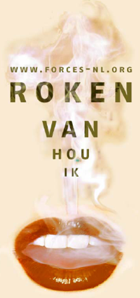Een fraai staaltje van misleiding was het volgende berichtje van ‘Second Hand Smoke consultant’ James Repace:
Dr Otsuka and colleagues1 showed that exposure to secondhand smoke with carbon monoxide (SSCO) levels of 6.02 ppm for 30 minutes induces endothelial dysfunction of the coronary circulation in nonsmokers. This exposure level can be related to actual secondhand smoke exposures by an equation relating SSCO to secondhand smoke respirable particulate matter (SSRSP)2: (1) SSRSP (µg/m3) = 247 SSCO (ppm) An equation relating the secondhand smoke biomarker salivary cotinine to SSRSP (8-hour daily exposure; respiration rate, 1 m3/hour) is3: (2) Salivary Cotinine (ng/mL) = 0.005 SSRSP (µg/m3) Thus, SSCO at 6.02 ppm corresponds to an estimated SSRSP level of (247)(6.02) = 1487 µg/m3. Similarly, by using both equations, an SSCO level of 6.02 ppm corresponds to a salivary cotinine level of (0.005)(1487) = 7.4 ng/mL. To put this in context, air at a bingo game had an SSRSP level2 of 1100 µg/m3. An automobile in which 3 cigarettes had been smoked4 had peak SSCO levels of 12 ppm and peak SSRSP levels of 3000 µg/m3. Workers in pubs had median salivary cotinine levels of 8 ng/mL.5 It appears that the levels of secondhand smoke that produce endothelial dysfunction in nonsmokers’ coronary arteries are typical of the high exposures encountered by many nonsmokers daily in hospitality venues and automobiles. This finding increases the urgency for legislative smoking bans in restaurants, bars, and casinos for the protection of workers as well as patrons and provides another important focus for state tobacco-control programs: to warn nonsmokers of the risks of passive smoking in automobiles. James Repace, MSc 1. Otsuka R, Watanabe H, Hirata K, et al. Acute effects of passive smoking on the coronary circulation in healthy young adults. JAMA. 2001;286:436-441. ABSTRACT | FULL TEXT | PDF | MEDLINE 2. Repace JL. Environmental CarcinogensSelected Methods of AnalysisVolume 9, Passive Smoking. Lyon, France: IARC Scientific Publications; 1987. 3. Repace JL, Jinot J, Bayard S, Emmons K, Hammond SK. Air nicotine and saliva cotinine as indicators of passive smoking exposure and risk. Risk Anal. 1998;18:71-83. MEDLINE 4. Ott WR, Langan R, Switzer P. A time series model for cigarette smoking activity patterns: model validation for carbon monoxide and respirable particles in a chamber and an automobile. J Expo Anal Environ Epidemiol. 1992;2(suppl 2):175-200. 5. Jarvis M. Measurement and estimation of smoke dosage to nonsmokers from environmental tobacco smoke. Br J Addict. 1992;87:111-113. MEDLINE |
Ziet er indrukwekkend uit nietwaar? En je denkt dat de cijfers boekdelen spreken.
Behalve als je naar de oorspronkelijke onderzoeksopzet teruggaat en tot verrassende ontdekkingen komt. In het volgende commentaar legt Lauren L. Colby uit waarom dit onzin en zelfs misleiding is:
It did NOT demonstrate that smoke has any adverse effect on endothelial function. To the contrary, this was the study in which researchers administered a drug, adenosine triphosphate, to induce an abnormally high blood flow through the heart. Then, they exposed the participants to second hand smoke for 30 minutes and observed that the blood flow began returning to normal. In the first place, just waiting 30 minutes for the drug to wear off would cause the blood flow to return to normal – smoke or no smoke. Second, even if it could be shown that the smoke had an effect, the effect was beneficial, since it counteracted the effects of adenosine, a drug known to have dangerous side effects. If the researchers wanted to show that smoke exposure reduces blood flow through the heart in normal people, they didn’t need to use adenosine to create an abnormal situation. The fact that they used the drug is the tip off that without using the drug, they couldn’t get the results they wanted. |


